On the second Monday in December, I click the link, open a window, and see myself. Instinctively, I adjust my posture. Anne Low has joined your meeting room. A couple of months earlier, I visited Low’s solo exhibition Bury Me at Franz Kaka on Dupont Street in Toronto. The show featured five works that engage with the domestic and the decorative. Inspired by pre-industrialized cloth samples, Low’s woven textiles are presented in sculptural forms; each work gestures towards the material evidence of housework: cleaning, mending, storing, tending, and washing.
An artist-weaver, Low works in sculpture, installation, textiles, and printmaking. After completing her fine art education at the Emily Carr Institute of Art and Design and later, at the Royal College of Art, Low studied at the Marshfield School of Weaving in Vermont in the summer of 2012, a place to which she has often returned. While craft and fine art tend to be understood as separate domains, Low has a foot in both realms. Her work is recognized highly in both fields. Low was shortlisted for both the 2017 Loewe Craft Prize and the 2019 Sobey Art Award.
Low’s work begins at the loom. Ever since finding this methodology, she approaches sculpture through weaving. She is partial to intricate stripes. Linen, wool, and silk are technically difficult to make but these textiles, along with cotton, are all found in the works included in Bury Me. Low constructed a boiler-suit in Clay suitcase (2023) and a skirt with an apron in Dream meadow (2023), each made from her handwoven, and sometimes hand-dyed, textiles. However, clothing is only an occasional form for Low. Chamber-lye (2020) features a cloth in relation to a utility sink, a juxtaposition that is more representative of her past work. Yet, both clothing and furniture relate directly to the body and one's interior world.
Peering into our computers from our respective homes — I blush when she compliments the worn log cabin quilt hanging as a curtain nearby me — we chat about the kinship she has found through weaving, the multiple lives of her textile pieces, how nature encroaches on our domestic interiors, and the challenges of creating a functional sculpture.
The sky was actually blue here this morning. I watched the clouds pass by my window for a while, but it’s overcast again. How’s winter for you? You’re on Denman Island?
The dark days have come as a bit of a shock. We are renting a friend’s house that is made entirely of wood that was felled and milled on the land here. There's no drywall, so it’s a very dark house in the evening. The short dark days feel extra dark. The fall has been really beautiful though. In November, we had tons of sun and now it’s very dark and rainy – as expected. I like this time of year.
Does your work or your life shift with the seasons?
It’s hard to say, in some ways. Because of the housing crisis out here [in the Lower Mainland and the Gulf Islands of British Columbia], I’ve moved four times in the last three years. I’ve lived on four different islands in the last three years. So that ability to access a rhythm that’s sustained over time with my work isn’t something I’ve experienced. It’s been a period of a lot of uprootedness. The studio has been something that I’ve tried to keep as the one thing that can be consistent throughout all of the moving.
I am wondering if your studio changes with your housing moves. Does it mean setting up a new studio each time?
Yep. (Laughs) I don’t think I’ve necessarily narrativized all these moves as impacting on my work, but they have meant that I’ve had periods where I haven’t been able to work, because I didn't have a studio. I was working in different ways, or in more research-based ways. I feel like a lot of artists living in Canada are familiar with this reality, because housing is so insecure everywhere. I think artists find ways to be very nimble, and find ways to work despite our circumstances being stressful a lot of the time with the disappearance of affordable studios in so many Canadian cities.
I thought we’d start by talking about your recent solo exhibition Bury Me at Franz Kaka, and then move from there to some past work. I’m interested specifically in the piece Dream meadow (2023), which seems to bring together a lot of elements that are common topics for you– the domestic in conjunction with craft, the feminine, the body, and sacred objects – all into one piece. I recall Kate [Whiteway] telling me about how you were given the dog hair, which is matted and hangs by a thread off the waist of the apron in Dream meadow, by a neighbour? I don’t know if this is true… Can you talk me through some of the elements in this work?
That work holds a lot of the different ways that I think – in terms of sculpture, and in terms of weaving.
I wove the silk component years ago, maybe in 2017 or 2018, as a research project. I had been looking at a lot of handwoven fabrics from an 18th-century sample book from Norwich in the UK. There was one particular stripe that had this small figure on top that my attention had gotten hooked on. At that point, I technically didn’t know how to weave the little figure, but the stripes I kind of understood, so I wove that piece of cloth to have a mechanical and technical understanding of these stripes, from a weaver’s perspective. I rolled it up and put it away for years, and then when I started to work on Dream meadow, the first thing that I did was get that silk out. I knew that I wanted to use it in a sculpture. I had also been cooking this idea of working with this structure of a skirt, or an apron as an armature for the basis of the work that would allow me to do other forms of thinking that are less structured and predetermined.
I can’t do that secondary form of unstructured thinking until I have a clear armature. This is something that is consistent through much of my work. By beginning with some kind of sculptural armature that I’ve observed through a form that already exists in the world, I can produce a space that I can then project a bunch of other stuff onto. Once that armature is determined it allows me to open up to a deeper channel that comes from an emotional understanding of an object, or an unconscious urge that is behind an object and build from a place that is a little more mysterious, a little more based on an urge, as opposed to a really explicit desire to make something look a certain way.
One of the elements in Dream meadow is an image of a standing, dead old-growth red cedar tree, which are fairly common in coastal BC. I took that picture on Malcolm Island, where I had been living at the time. It stands in a forest that I had spent a lot of time in, and this particular tree captured my attention because it felt like a sculptural form in the forest. Because it’s dead it has a different quality in terms of its density, as though the form is held in place by a hollowness of material. While living on that island, which is up near the northern end of Vancouver Island, it became a form that I was really fascinated by. I had the urge to represent my relation with its form in a work through a photograph, which is something I hadn’t ever done before. I wanted to make my own sort of cheap, fake postcard. It was a way to pause a thought, or pause a relationship to that object in the world, making this little postcard was a way of capturing that relation. Dream meadow is a lot about the fantasy of living outside of the city and processing the experience of when a dream becomes reality, and it, of course, is in no way what one expects. A lot of the other components in the work are imaginatively and materially processing a direct experience while also reflecting on it more holistically and broadly. Having lived in a very remote and wild part of the coast I quickly realised that nature and all of its vitality is perpetually encroaching on all domestic human activity. This work is a lot about that border. Each of the handkerchiefs on the skirt are painted with patterns of wood louse, carpenter ants, and mildew. They serve as an ornamentation of rot. Clipped to the side of the sculpture are millwork profiles, which serve the fantasy aspect of the work, similar to the crisp white linen apron.
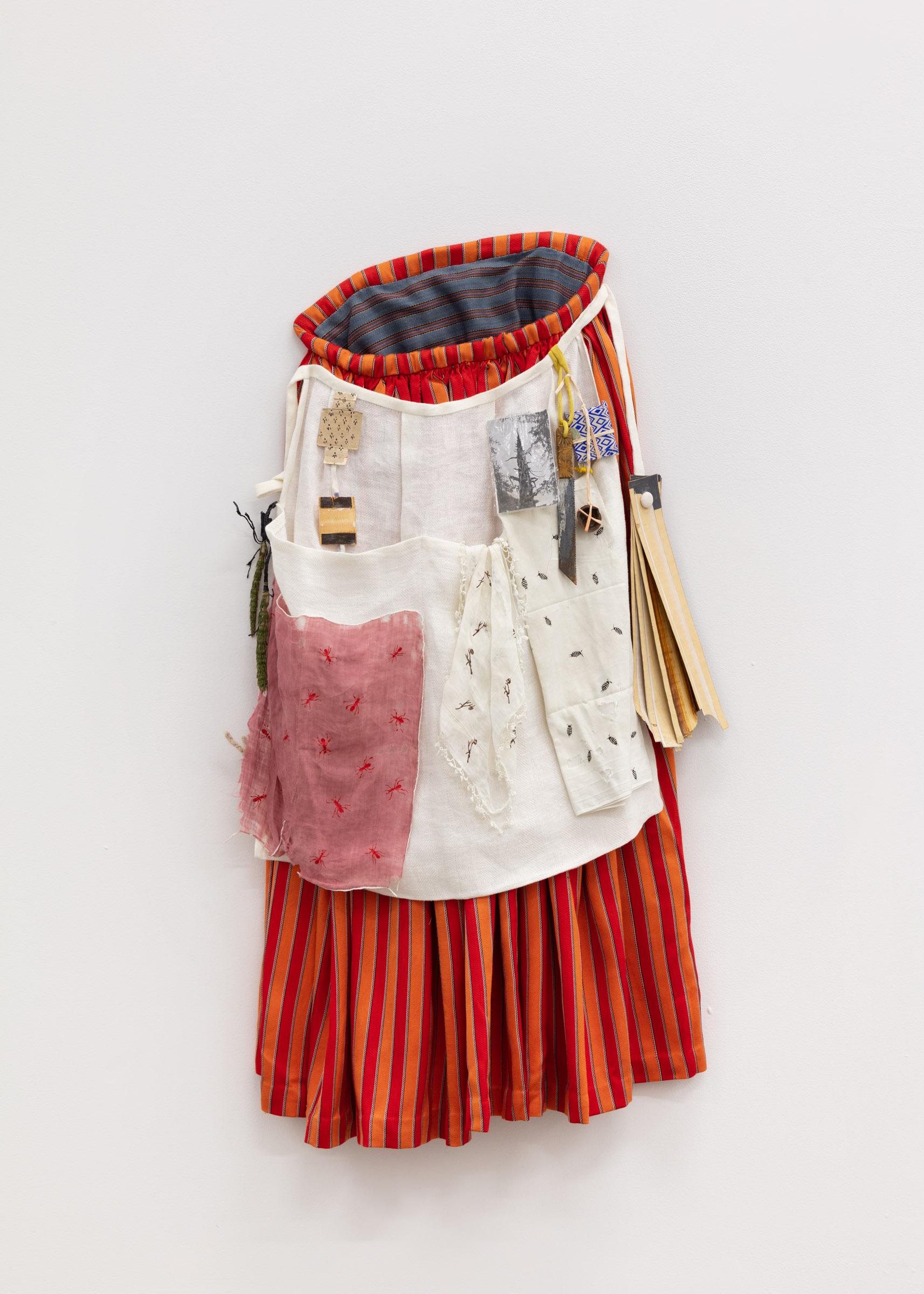
Dream meadow, 2023, Hand woven and hand dyed wool, hand woven linen, hand woven silk, found textiles, paint, paper, photocopy, horsetail, dog hair, metal, wood, found nut shell, tissue paper, match strike pad
37 x 19 x 5 inches
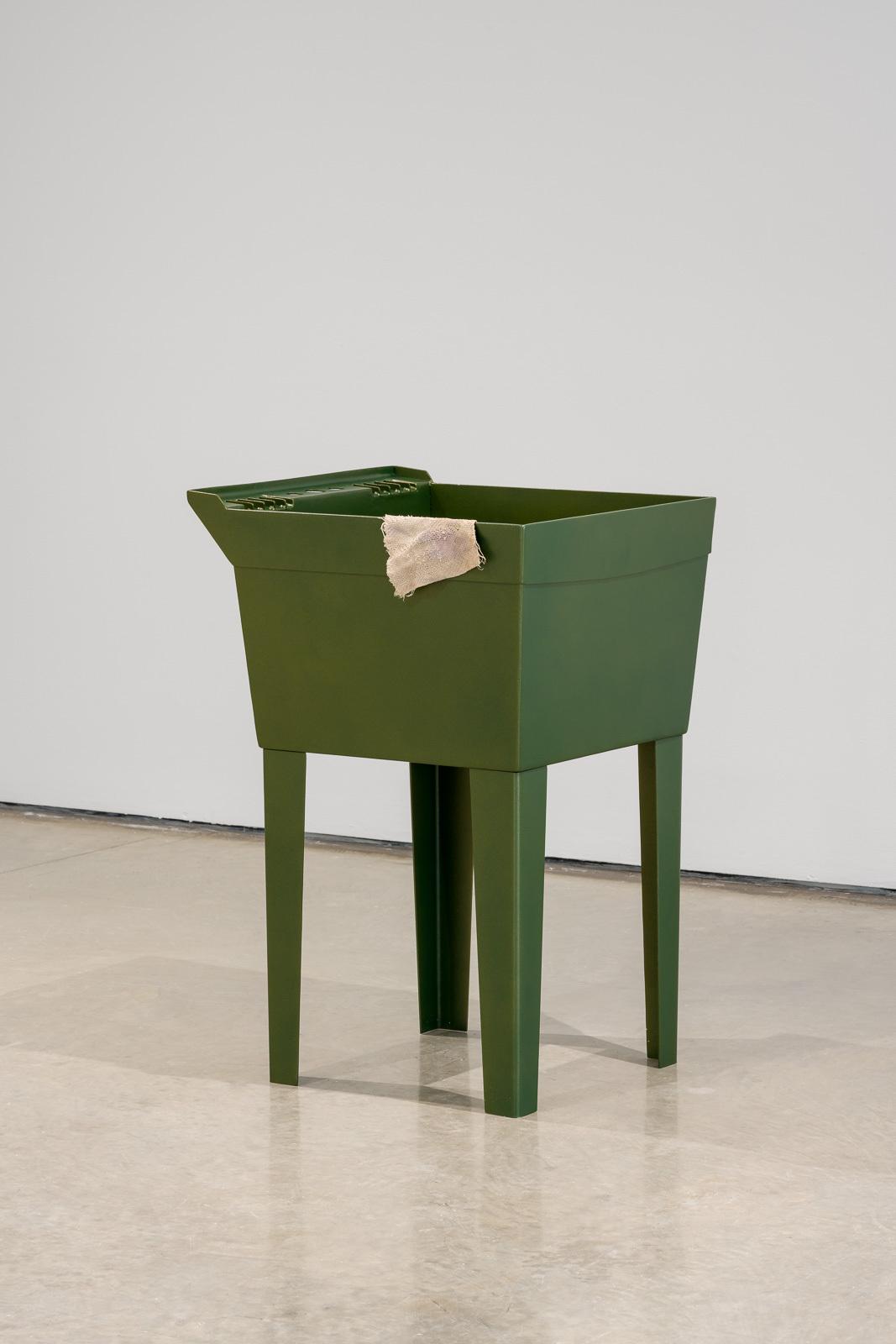
Chamber-lye, 2020 Welded and powder coated steel, 34 ½ x 22 ½ x 22 ½ inches
In a number of the works in Bury Me the textile seems to be performing activities, such as cleaning the sink. Can you speak about how domestic labour plays a role in your work?
The title of the sink work is Chamber-lye (2020), which is a historical term for soap made of fermented urine. I’m interested in something like soap, which is used to clean a surface, being made with something like fermented piss, which is truly the most foul smelling thing on the planet. Things, like sinks and rags, are related to activities that have to do with cleaning and maintaining, and keeping degradation, or dust and dirt and grime, at bay. I think a lot of my work is trying to hold that or find that edge between the thing that’s encroaching and the thing that’s pushing it back.
Can you tell me about the textile component of Chamber-lye (2020)?
The rag that’s on that sculpture presents itself as a rag ultimately, but its life as a textile stretches back through all of these other modes. It began when I wove a bunch of samples for a project that I did at Mercer Union in 2018 in collaboration with Evan Calder Williams called A fine line of deviation, which consisted of a handwoven screen that Evan’s film was projected on.
I wove a tonne of different samples of cloth. We were thinking about the relationship between this projected image and the service of a textile to that image. So I had all of these handwoven cotton samples left over from this project, and at a certain point, I thought, these would make really good dish rags. For years, these rags, that were formally woven with the intention of being a screen, were circulating through all the banal domestic activities of my life, such as wiping a counter. They started to accumulate this patina, which I couldn’t have invented or replicated if I tried. I was really interested in how, cycling through all of this work of being a piece of cloth being used, it had built up all this information that was immediately very captivating to me. It had been able to weave in and out of these systems of being practically useful and then being considered within an artwork.
There’s actually two works that came from that original pile of rags. One is another small sculptural work that hangs on the wall and is made out of a stack of rags. But for the one that is in Chamber-lye, I wanted to find an armature that could hold this rag in a space where it’s not just being pinned in the wall, where I’m not simply asking it to be a picture. I wanted to find a form where it can exist in a sculptural realm, where it can maintain its integrity as a rag, in a subtle, but true way. That’s how I arrived at the form of the sink. It's a literal facsimile of those plastic utility sinks that are so common, that everyone likely grew up with in their basement or laundry room. They are very ubiquitous. It’s quite big, heavy, and a very familiar form that can hold up this very small, quiet thing. I’m always really interested in how cloth exists in relationship to form. So that piece is really about the familiarity of the sink, being able to hold up the material knowledge, or evidence, that’s held in that little woven scrap.
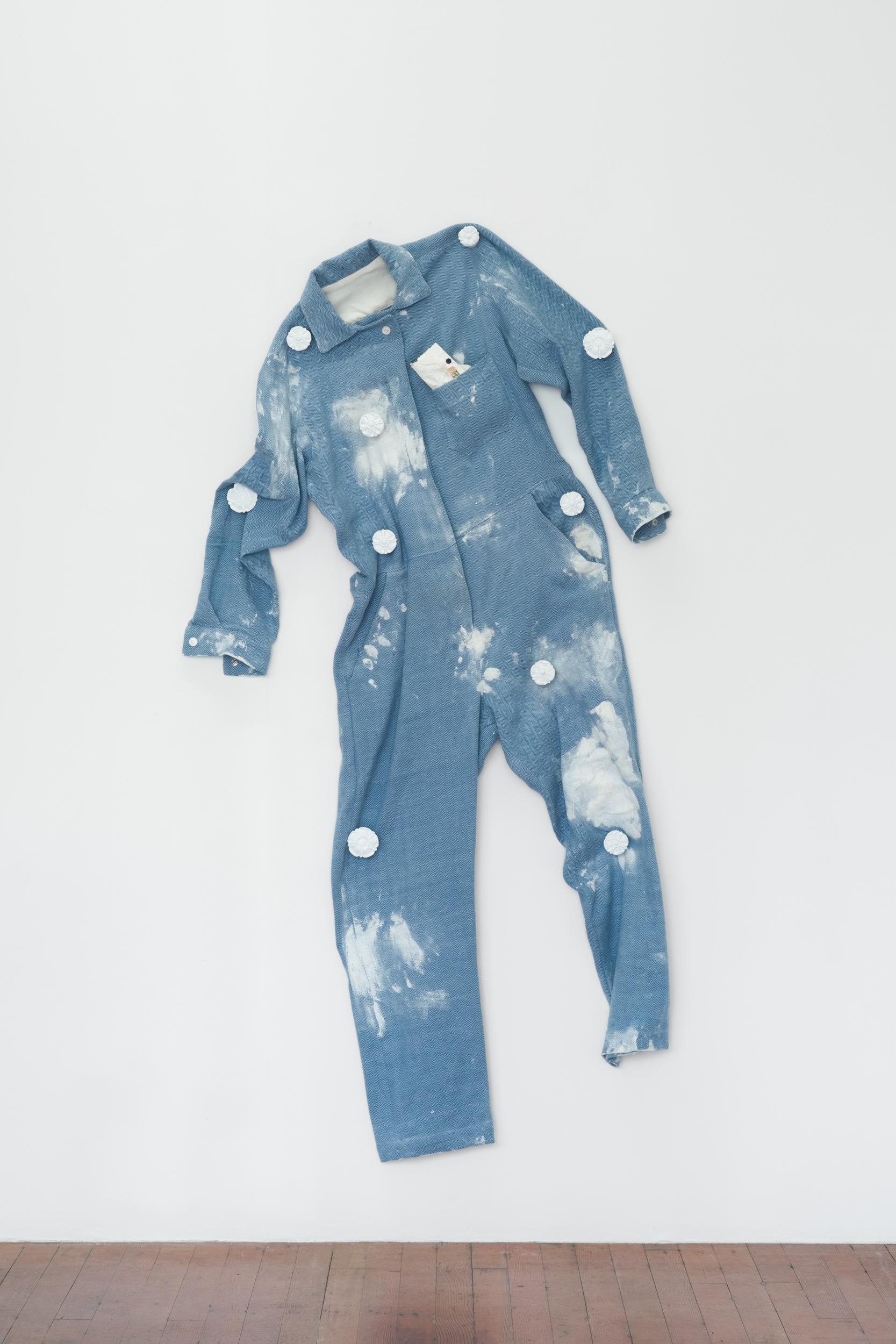
Clay suitcase, 2023, Hand woven cotton and silk, calcium carbonate, hide glue, wood, plaster, metal
60 x 35 x 2 inches
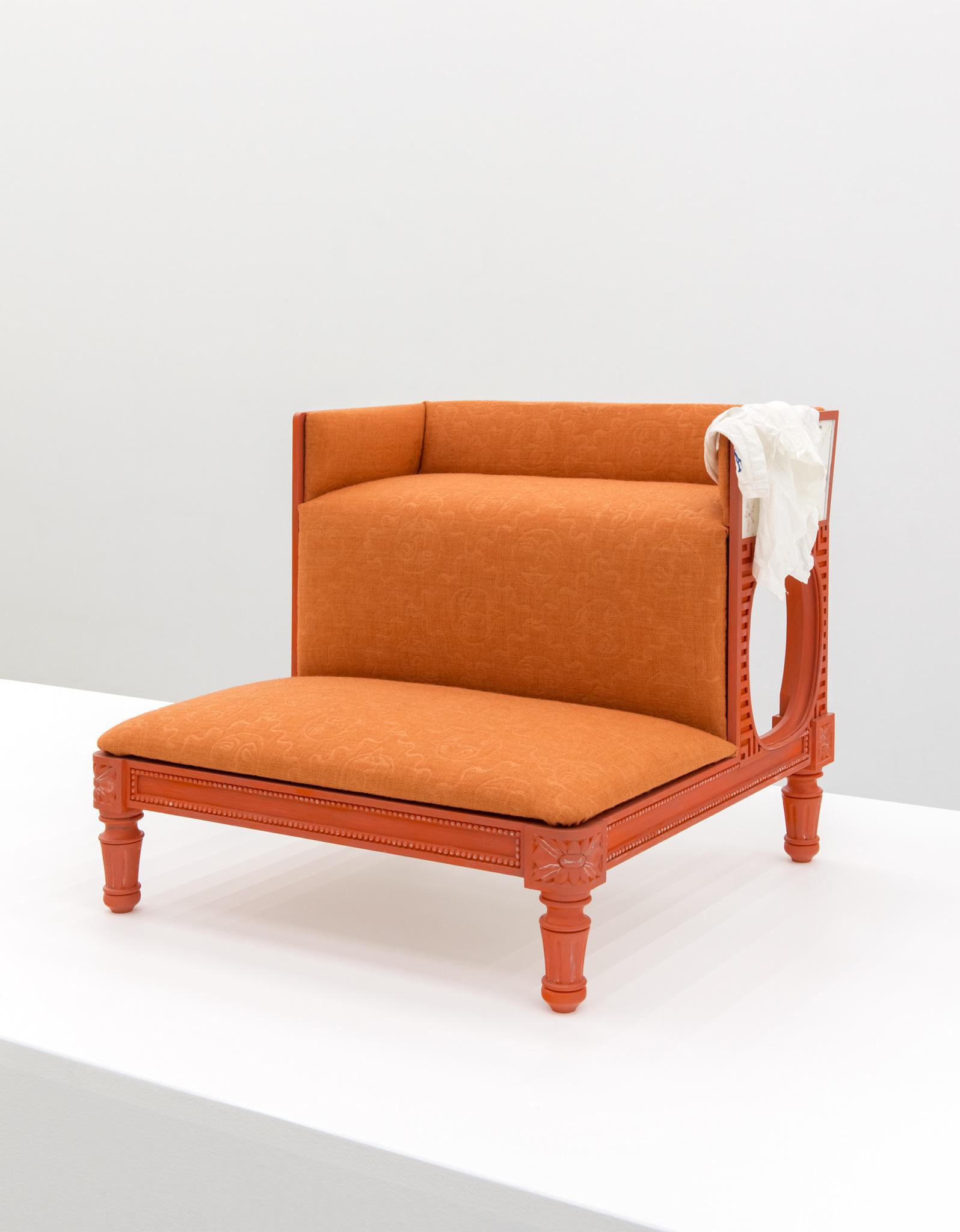
Bedchamber of a paper stainer (bedsteps), 2018. Brass nails, calcium carbonate and hide glue composite, foam, handwoven and hand dyed embossed wool, paint, paper, wood
17 ½ x 22 x 21 inches
I had a déjà vu moment while looking at Clay suitcase (2023). There is a small image of a face on a torn piece of paper tucked into the breast pocket of the boilersuit. While looking through your past work I realised, it is included in your work Garbage eater (2018). Can you speak about this image? Where is it from?
A senior yoga teacher that I used to practice with in Vancouver often had these very poetic descriptions of poses, and there’s one where you stick your tongue out as far as you can and exhale. She described it as “opening your face like a flower,” and it stayed with me. I had this idea of opening up your face; what comes out of a face in an energetic way when one exhales. So I started drawing this face opening up and it landed with a face with its tongue sticking out and slightly pained eyebrows.
My 2017 exhibition, Witch with comb, at Artspeak in Vancouver was the first time I used that drawing. It appeared in a really subtle way in that show. I had a rubber stamp made of the drawing. It was stamped on the tissue paper used in these paper flowers that were hanging down from a series of painted boards that served a sculptural frieze up on the upper part of the gallery wall. Then later, for my exhibition Paperstainer at Mercer Union, I used it as the basis for a pattern in a textile in the work Bedchamber of a paper stainer. I was able to commission my weaving mentor, Kate Smith, to produce an embossed woollen upholstery fabric. Kate has an incredible company where she reproduces historical fabrics and one of the fabrics she reproduces is an embossed wool. I took my little tongue-sticking-out face and developed it into a larger all over pattern, which was then transferred to a metal plate used in the embossing process.
I also used the little faces in some other works as well. It was in the show [Medlar] I did at Unit 17 in 2021. I stamped the face on a tiny piece of tissue paper which was pinned to the wall with a little cast silver fishing hook that’s been unfurled from its hook shape into a small pin.
This little face has become a sign of life I think. If I’m writing someone a letter or sending someone a package, I put that stamp on it. It’s not really a signature, but rather an ingredient I can draw on when needed. It holds this energy of breath, of something inside being expelled outside.
Thinking about how you describe this little face recurring, and how your hand woven screen eventually became or re-emerged in Chamber-lye (2020), and how you look to past weaving samples, I’m curious about your relationship to time. Does looking back propel you forward somehow?
One of the meaningful capacities of being both an artist and weaver is that you are able to have kinship with people who engage in the same systems of practice, systems of knowledge, or systems of exploration. So when I learned to weave, over 13 years ago now, I went really deep into that world. I learned to weave from people outside of the artworld, outside of an idea of fibre art, outside of an art school, in a very traditional setting. My teachers were people who make their livelihood from weaving. The thing I really gained from studying in that environment was this deep sense of connection. Weaving is essentially the same principle everywhere yet shifts in expression depending on who’s holding the tools. That same principle has also been enacted since the beginning of humans being humans. Finding that knowledge system for my work alleviated a sense of the existential disconnection that I had and made me feel connected to something in a deeper way. It just kind of grounded me. I think art-making produces kinship in a way that is very grounding with bonds both real and imagined.
The deeper trajectory of my research into cloth histories is into the long, unbroken traditions of weaving prior to industrialization, because that’s where you see so much intelligence and material knowledge baked into the cloth itself. I’m interested in all the knowledge that can be held in a tiny little scrap of pre-industrial cloth. When I’m looking at historical sample books of cloth I’m really curious about not only the material constituencies of that cloth, but I’m also imagining; What were the conditions of the weaver’s labour? Did they weave at home? In a workshop? Beyond the piece of cloth itself, I’m interested in the personhood and experience of weavers as well.
Looking at historical material, it makes me feel connected. It gives a deeper humanness to what I’m doing. I always talk about weaving being the ground from which I work as an artist. I really need the groundedness of weaving to do my work which involves working more critically, more mysteriously, and more tied to these things that are harder to put a pin in.
I have been scrolling through your instagram and there is a post of Mother furniture (2020). In the caption you wrote “Years ago, I saw a Noguchi coffee table on display at the Musée des beaux-arts de Montréal, whose surface had a ghostly ring of white on the surface, from sweaty glass of water or a dirty teacup. When I made Mother furniture the plan was for it to never live in a crate when it wasn’t in an exhibition, that it was going to gain the patina of life in my house.” I’m curious where this work is residing now?
It’s a chair at our kitchen table. I made Mother furniture at a time when I was thinking about the status of works when they are in storage because a lot of my work is in storage. I wanted to find a way where I could make a work that could hold both of the status of being in an exhibition and also be something in my home that's useful and then when it goes back into an exhibition again after a period of use, it can hold – similar to the dishrag in Chamber-lye – all this accumulation of a material information that you can only really achieve through use, that can’t be planned. All of these actions that impact on the chair in our home just happen, because of the process of living.
The idea I proposed in that work was to make a sculpture that was also, literally, a chair. To make a functional and comfortable chair is very challenging. There’s a reason why certain vernaculars persist, and it has a lot to do with joinery. The physics of sitting are incredibly complex, and there’s a reason why some chairs you want to sit in and some chairs you don’t want to sit in. It’s a lot to do with angles, where your feet go, all sorts of things.
Making that work posed specific challenges, because of my desire for it to have a double life. It wasn’t just a sculpture of a chair, it was literally a chair. A lot of the wood fabrication I do is with my brother, who is an incredibly skilled woodworker and carpenter. He trained as a boat builder and thus has a remarkable knowledge of wood and making wood do specific things. Of all of the works I’ve made that rely on someone else’s fabrication – I'm obviously not a woodworker – this one was a different kind of challenge because it was pushing up against my idea of how I thought something should look, and the reality of why things look a certain way when it comes to furniture. By this I mean the reality of gravity and the human body impacted sculptural decisions in a new way for me. Function was more of my boss than I was of it. It was an interesting process and now that it's not in an exhibition and it’s in my house I’ve learned that it is a comfortable chair and we do want to sit in it at the table. For me, it was really important that it wasn’t a bad version of a chair because it’s a sculpture, or vice versa. It holds this other thinking that I was wanting to do in that work around the way things are made. Why are things made a certain way? When 99% of something is determined by what it needs to be, what’s the 1% of subjectivity that can be squished into that form?
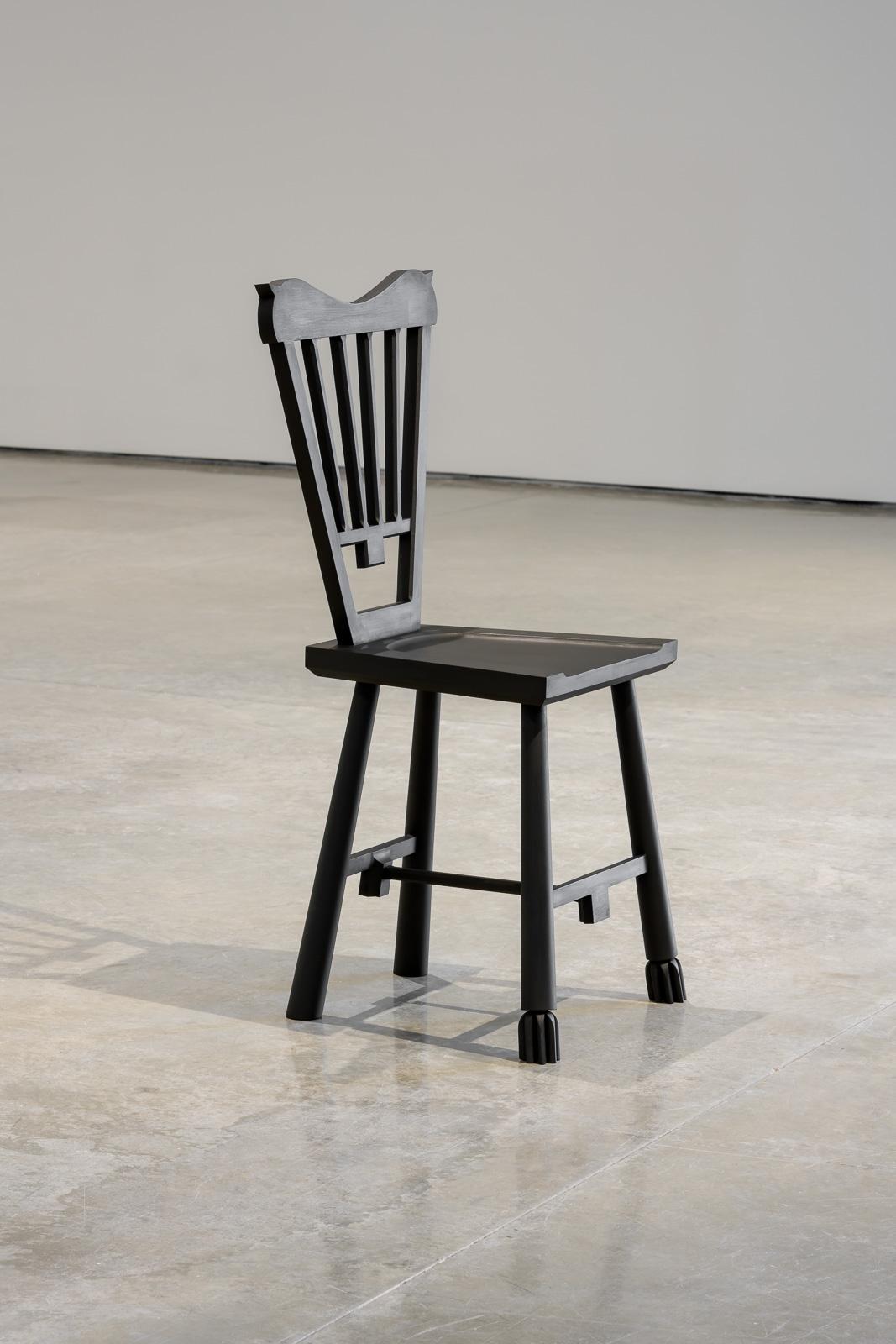
Mother furniture, 2020, Cherry, milk paint, oil, 36 x 16 x 14”
Has it changed since moving it from the gallery space to your kitchen table?
I think it’s less of an idea now. When it was in the gallery, because no one was sitting in it, it was almost like a silhouette, or an idea, or a shadow of a chair. Now that it’s in my house, I’m slowly seeing processes I knew would happen, and that I wanted to happen, transforming the chair very slowly. The work is finished with milk paint and oil which is a finish in which over time the pigment slowly gets rubbed off the sharp edges of the chair and you start to see a tiny, tiny shimmer of the cherry hardwood that the chair is made of. The edges of the chair start to appear in a different way caused by the simple rubbing of someone sitting in the chair over time. I love seeing this in historical chairs; with use of the chair, you see what it’s made of on the edges. That’s something that I knew would happen and it’s interesting to see the pace at which it’s happening, and how it’s shifting the chair to look really different now. It has a totally different quality now, it feels like this inhabited thing that holds all of this information that is completely out of my control.
In 2017, in collaboration with Ashes Withyman, you curated Kitchen Midden at Griffin Art Projects, “an exhibition of artworks, artefacts and objects from the collections of artists based in Vancouver and its outlying areas.” What collections inhabit your space? What collecting do you do?
I’m pretty limited. I have a low bandwidth for having a lot of visual information around me. The things I have around me that are important are in the realm of function, like pieces of furniture that my brother has made, or we have a couch that belonged to my partner’s great-grandfather. I wove a woollen cloth for it, and we had it upholstered. So my material world is very directly related to function. But my partner collects – when I say “collect,” he does this as an artist – I feel like he fills in more of that capacity in our household than I do. In terms of the things I have collected it’s very few. I have a work by Peter Collingwood that’s really important to me, he was a British handweaver. Within the weaving world, he’s a really important figure; he wrote a series of books on weaving, but he was obsessed with techniques and mechanics. He studied a lot of historical textiles, and then later in life started making more sculptural wall works that I’m really interested in. He was very, very prolific. I happened to be able to buy a work off of Ebay by him, for not a lot of money. That’s very important to me. I’m very limited on the amount of textiles that I collect. I just find the weight of that a little too much sometimes, I feel too much responsibility with it. I do have some quilts that were made by my grandmother and great-grandmother that are very important to me. I was very fortunate to be taught to sew and knit from my grandmother and building acuity with my hands from a young age is something I deeply value. The quilts I have from her are the most important material things in my life, they have a certain soft precision that I admire.
There’s actually a work that was in the show at the SAAG [Southern Alberta Art Gallery] in Lethbridge that’s a kind of a big bag, like a laundry bag, made of handwoven silk. Inside that bag are all these textiles that I’ve either made, or have been given, that I don’t visually or materially want to have in my day-to-day life, but also don’t want to get rid of them. So that work basically holds all of this material that I have a relationship with, where I can’t let them go, but I also can’t live with them. I solved my problem with these textiles by absorbing them all into a sculpture.